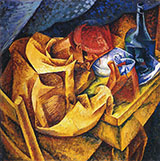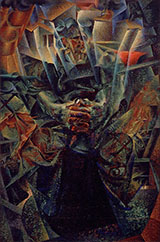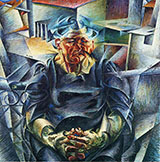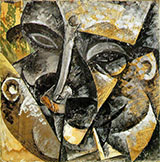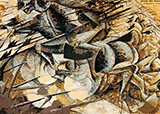Post Expressionism Oil Painting Reproductions
Find Post Expressionism oil painting replicas by Post-Expressionism artists
Post Expressionism: A Brief Introduction
Post Expressionism is a term in Art History, first used by the German art theorist Franz Roh. It is a broad category covering many artistic movements emerging from World War One. However, their response to Expressionism links all these art movements. While the Expressionist artists' approach inspired some, others rejected it entirely.
This brief introduction presents some of the most famous Post Expressionist artists. We also explore their fascinating colorful abstract paintings. From paintings by Paul Klee and the enigmatic creations to art by Wassily Kandinsky, here is everything you need to know about Expressionist paintings.
What is Expressionist Art?
Before we discuss Post Expressionism, let us explore Expressionism art. German Expressionist oil paintings first appear in the early 20th century. Expressionist artists responded to a rapidly modernizing world. As a result, their Modern Art oil paintings often reference feelings of isolation and lost connections with nature. Bright colors, city scenes, natural forms, and animals were standard features.
Expressionism versus Impressionism Paintings
Expressionist art was a reaction to French Impressionism. Many famous artists, such as Vincent van Gogh and Edvard Munch, considered Impressionism paintings too decorative and frivolous. Instead, they derived inspiration from the developments in Symbolism paintings. These artists expressed their inner emotions and psychological turmoil where self-expression was vital; hence the term Expressionism art. The main phase of Expressionist art lasted from 1905 to 1920. As an art movement, it abandons earlier commitments to artistic order and tradition. In place of these rules, the artist’s emotions reigned supreme. Expressionism art largely petered out after the bloodshed of World War One.
What is the definition of Expressionism Art?
Post Expressionist art generally uses a more careful and considered artistic style than Expressionism oil paintings. After the First World War, there was a broad call for a return to order. In addition, artists sought a new appreciation of tradition, culture, and the natural world. This shift resulted in something called The New Objectivity, or Neue Sachlichkeit, championed by German and Italian artists. This new artistic movement rejected more emotional Expressionist approaches. Two groups emerged within New Objectivity art. These are known as the Verists and the Classicists. Verists strove to represent the truth of their modern, uncertain times. On the other hand, Classicists aimed for timeless compositions.
Along with these two approaches, other versions of Post Expressionism painting emerged. Magic Realism, championed by Antonio Donghi and Anton Raderscheidt, and the darkly satirical work of James Ensor were particularly influential. Magic Realism emphasizes the magic and wonder of the natural world and everyday objects. On the other hand, paintings by James Ensor present people in frightening masks, carnival outfits, and unsettling scenes. They were accompanied by fevered brushstrokes and garish contrasting colors, which gave a strange unease to familiar subjects.
What are three examples of Post Expressionism Painting?
While Wassily Kandinsky and Paul Klee were notable figures in the development of Expressionism painting, they also championed Post Expressionism. They consequently supply a fascinating insight into how Expressionism moved towards Post Expressionism after the First World War.
Here are three artists associated with Post Expressionist art.
1. Amedeo Modigliani, Reclining Nude 1919
Modigliani is a complex artist to define but generally falls into the category of modern art oil paintings. Nonetheless, his portraits share many similarities with Post Expressionism. Instead of focusing on his own emotions, Modigliani created intriguing nude paintings. They featured elongated bodies and a return to the ideals of famous Renaissance paintings.
Inspired by the Renaissance oil paintings of Titian and Sandro Botticelli, Modigliani presented his version of the classic Renaissance nude oil painting. Modigiliani's series began in 1916 and takes inspiration from Italian Renaissance Venus paintings. Unlike classical approaches, however, Modigliani gave his female nude paintings an erotic directness. The skin of the reclining nude shines against the red couch, and any hint of mythology disappears. The naked female body is the sole focus of Modigliani's famous painting.
2. Paul Klee, Castle and Sun 1928
Paul Klee Castle and Sun is one of the artist’s best-known colorful abstract paintings. While the painting depicts a city, Klee abstracts each building into geometric forms. With rectangles, squares, and triangles sitting on top of one another, it builds into a strangely calming scene. Finally, a lone circle appears at the top of the canvas, representing a shining sun above the urban view.
Paul Klee worked across many artistic genres, including Expressionism, Surrealism, Post Expressionism, and Cubism. Nonetheless, his art resists simple definitions. Other Paul Klee paintings, like, for instance, The Cat and the Bird, also question the boundaries between reality and abstraction. Indeed, a small bird flies inside the cat’s forehead, suggesting that It is literally on his mind. The head of the cat fills the entire composition with Klee concentrating on thought and mental processes rather than simple figurative painting.
Paul Klee famous abstract art paintings are some of our most popular famous painting replicas.
3. Wassily Kandinsky, Several Circles 1926
Kandinsky paintings demonstrate the fascinating link between the Expressionist and Post Expressionist art movements. Indeed, Wassily Kandinsky was a central member of Der Blaue Reiter artists group, which played a significant role in German Expressionism.
As the 1920s progressed, Wassily Kandinsky abandoned earlier figurative approaches. Instead, he moves towards abstract art, focusing on the balance of color and archetypal forms. Among these forms, circles were fundamental to Kandinsky, which he felt was the purest artistic shape, representing universal ideas of balance and harmony. The shift towards abstraction is already visible in earlier Wassily Kandinsky famous paintings like Improvisation 28, Second Version 1912, and its colorful art.
What Art Movement came after Post Expressionism Art?
As a movement, Post Expressionism art was relatively short-lived. The culmination of the Second World War in 1945 brought an end to the Post Expressionist artist's call for a return to order. The sheer horror and slaughter of the Holocaust led to another reimagining of art and culture. After this date, movements such as American Abstract Expressionism emerged, linking with approaches such as Action Painting, championed by artists such as Jackson Pollock, demonstrating America’s new-found confidence.
Abstract Expressionism also fed into the quieter Color Field style, which flourished during the 1950s and early 1960s. Famous oil paintings of the modern art movement began to feature pure blocks of color, conforming almost entirely to Abstract Art.
Famous Expressionist Artists: Colorful Abstract Paintings for Sale
If you adore Post Expressionism art, explore our extensive collection of high quality art reproductions for sale. Whether it’s Paul Klee Castle and the Sun or Kandinsky paintings, enjoy thousands of oil paintings in our vast catalog of oil painting reproductions.
You can now buy colorful paintings by famous artists. We specialize in oversized wall art; all our replica paintings are available in large sizes.
Cannot Find What You Are Looking For?
Reproduction Gallery Information
Customer Service
(Send Us A Message)
Tel: (503) 937 2010
Fax: (503) 937 2011




